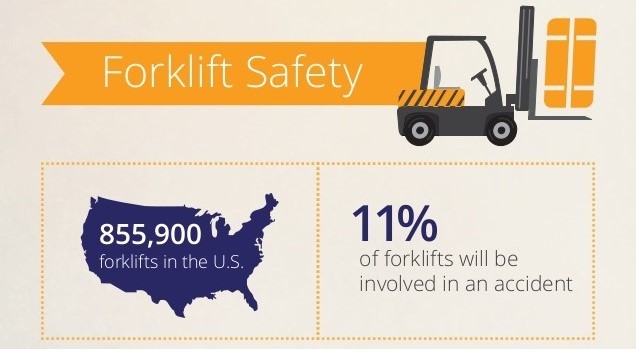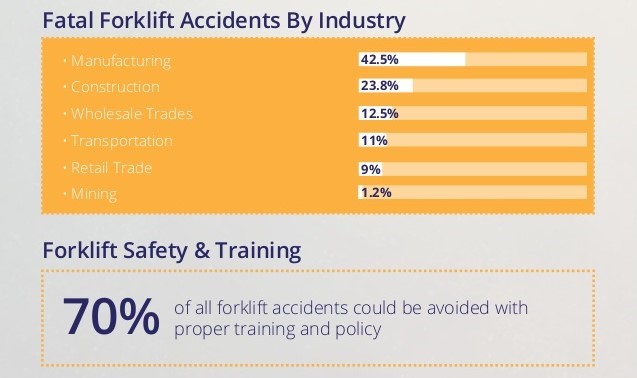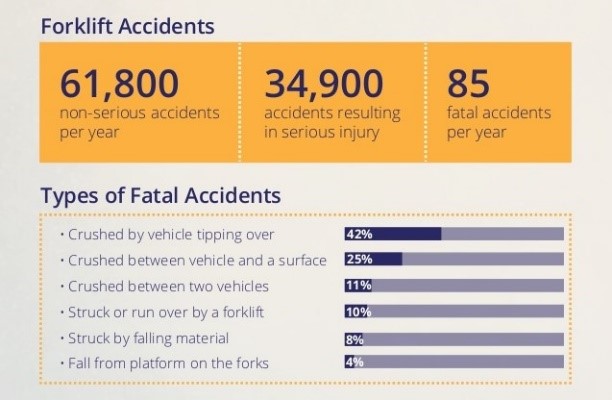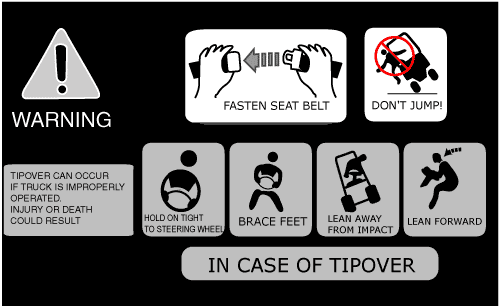Focus on Forklift Safety

Forklifts weigh more than three tons, and can reach a speed of 10 mph. These mechanical giants are great at assisting labor, yet can also be a source of danger.
OSHA estimates that 35,000 serious injuries and 62,000 non-serious injuries involving forklifts occur annually. Further, data from the Bureau of Labor Statistics shows that 96 U.S. workers were killed in incidents involving forklifts in 2015 (average is 85 fatal accidents).
Forklift Safety Facts



Potential Hazards
- Hitting head on overhead cage.
- Slips, trips and falls when an employee is entering and exiting the forklift.
- Overturning forklift.
- Collision with a pedestrian, another vehicle or an object.
- Falling load.
- Loss of steering control (Shifting too much weight forward raises the rear wheels).
Tips to Improve Safety
Clothing/Protective Equipment
- Wear the appropriate safety work wear. This usually consists of a hard hat, safety shoes and hi-visibility jackets.
- The workwear must be reasonably fitted as any loose clothing can get caught on machinery.
Personal Care Tips
- Be sure that your hands are clean and dry to prevent slipping when grabbing handhold.
- Check your shoes and clothing for grease or other substances before entering the vehicle.
Physical Tips
- Pull or lower your body carefully into or out of cab. Dismounting is the opposite of mounting – do not jump.
- Ensure that a comfortable operating position is found and all controls are within easy reach.
Operating Tips
- Conduct a pre-operation inspection.
- Conduct an operational check after starting the engine.
- If there are any noted damages or problems management should be notified and the forklift should not be operated if it needs to be repaired.
- Make sure loads are correctly stacked and positioned across both forks.
- Know the capacity of your forklift and any attachments being used and never exceed this capacity.
- Forklift seat belt is to be fastened when operating a forklift.
- Ensure that your way is clear. Proceed cautiously down the travel path watching for dangerous blind spots.
- Do not park in an unauthorized area and do not block an aisle or exits.
- Use a horn or warning light to warn pedestrians when reversing.
- Consider the noise level in your workplace. Do not assume pedestrians or bystanders are able to hear a back-up alarm.
- Do not authorize anyone to stand or walk under the load or forklift machinery – The load can fall causing injury or death.
- Understand and use the ‘stability triangle.’
- Anticipate the rear-end swing and start the turn as close to the inside corner as possible. Plan your route and anticipate turns.
- Be aware of the height of the load, mast and overhead guard of the forklift when entering or exiting buildings.
Tipover Tips.
There are two basic type of tipovers in a forklift: 1) a forward tip or longitudinal tip, and 2) a lateral or side tip. The procedure to follow in the event of tipover varies depending on the type of tipover and the class of forklifts that you may use in your facility.

If companies implemented more stringent training policies, the Occupational Safety & Health Administration (OSHA) estimates that about 70% of forklift accidents in the U.S. could be prevented. Get in touch with our team to improve the safety of your employees!
_
4652 Belden Village St NW
Canton, Ohio 44718
(330) 915-2355
